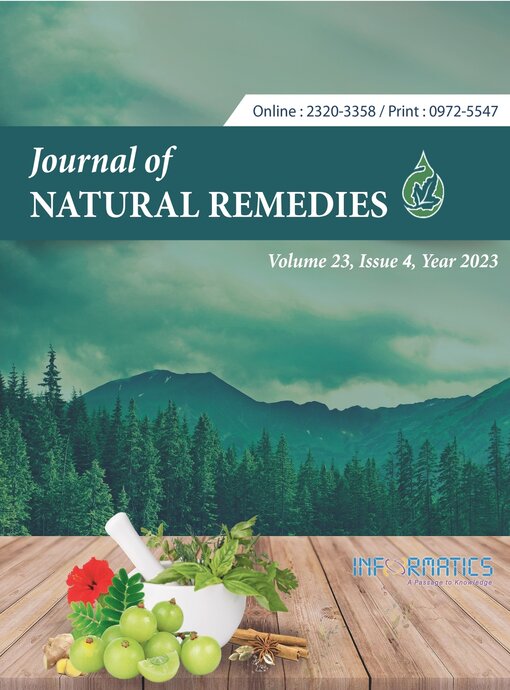Thymol as a Potent Anti-Schizophrenic Agent in Swiss Albino Mice
DOI:
https://doi.org/10.18311/jnr/2023/33997Keywords:
Anti-Schizophrenic Activity, Aripiprazole, Dopaminergic Antagonist, Neurotoxin ThymolAbstract
In ancient medical systems, the plant Thymus vulgaris L. was used widely for various medicinal purposes. The leaf portion of Thymus vulgaris L. along with its isolated active phytoconstituent thymol was studied in the management of anti-schizophrenic activity in Swiss albino mice. The present work deals with the in vivo antischizophrenic activity study of thymol by inhibition of apomorphine climbing mice and methamphetamine-induced stereotypical behaviour in mice models. Thymol was isolated from Thymus vulgaris L leaves and confirmed by TLC and FTIR spectroscopy. Experimental works included Actophotometer, mice treated with Thymus vulgaris leaves extract TVLE (50mg/kg and 100mg/kg) and its bioactive moiety thymol (5mg/kg) along with aripiprazole (1mg/kg). Investigations of the anti-schizophrenic activity of TVLE (50mg/kg and 100mg/kg) and thymol (5mg/kg) showed a significant (**p<0.01) results in both models of methamphetamine-induced stereotypy and apomorphine climbing time in experimental mice. Based on the experimental findings TVLE and thymol were shown to be very much effective as anti-schizophrenic activity. The results explained the role of thymol acting like a dopaminergic blocker or by causing a decrease in the brain’s dopamine supply to improve the schizophrenic-like behaviour in Swiss albino mice.
Downloads
Metrics
Downloads
Published
How to Cite
Issue
Section
License
Copyright (c) 2023 Madhvi Singh, Saumya Das, Avijit Mazumder (Author)

This work is licensed under a Creative Commons Attribution 4.0 International License.
Accepted 2023-09-11
Published 2023-11-10
References
Westh H, Zinn SC, Rosdahl VT, Sarisa Study Group. An international multicenter study of antimicrobial consumption and resistance in Staphylococcus aureus isolates from 15 hospitals in 14 countries. Microbial drug resistance. 2004; 10(2):169-76. https://doi.org/10.1089/1076629041310019 PMid:15256033 DOI: https://doi.org/10.1089/1076629041310019
Cassileth, Barrie R. Complementary therapies: The American experience. Supportive care in cancer. 2000; 8:16-23. https://doi.org/10.1007/s005209900036 PMid:10650892 DOI: https://doi.org/10.1007/s005209900036
Patel, Krishna R, Cherian J, Gohil K, Atkinson D. Schizophrenia: overview and treatment options. Pharmacy and Therapeutics. 2014; 39(9):638.
Kirkbride, James B, Fearon P, Morgan C, Dazzan P, Morgan K, Tarrant J, Lloyd T, et al. Heterogeneity in incidence rates of schizophrenia and other psychotic syndromes: findings from the 3-center AeSOP study. Archives of general psychiatry. 2006; 63(3):250-8. https://doi.org/10.1001/archpsyc.63.3.250 PMid:16520429 DOI: https://doi.org/10.1001/archpsyc.63.3.250
Picchioni, Marco M, Rijsdijk F, Toulopoulou T, Chaddock C, Cole JH, Ettinger U, Oses A, Metcalfe H, Murray RM, and McGuire P. Familial and environmental influences on brain volumes in twins with schizophrenia. Journal of Psychiatry and Neuroscience. 2017; 42(2):122-30. https://doi.org/10.1503/jpn.140277 PMid:28245176 PMCid: PMC5373701 DOI: https://doi.org/10.1503/jpn.140277
Jose, Sonja, Jaykar B. Isolation, Characterization, and phytochemical evaluation of active compound thymol from Cyclea peltata (Lam). Nveo-natural volatiles & essential oils journal nveo. 2021:10803-12. https://doi.org/10.9734/jpri/2021/v33i44A32619 DOI: https://doi.org/10.9734/jpri/2021/v33i44A32619
Hanan OA, Abdel-Rahman RF, Elbaset Mohamed MA, Ahmed-Farid OA, Khattab MS, Abd-Elsalam RM. Thymol ameliorated neurotoxicity and cognitive deterioration in a thioacetamide-induced hepatic encephalopathy rat model; involvement of the BDNF/CREB signalling pathway. Food and Function. 2022; 13(11):6180-94. https://doi.org/10.1039/D1FO04292K PMid:35583008 DOI: https://doi.org/10.1039/D1FO04292K
Amzad MH, AL-Raqmi AS, Al-Mijizy ZH, Mohammed Weli A, Al-Riyami Q. Study of total phenol, flavonoids contents and phytochemical screening of various leaves crude extracts of locally grown Thymus vulgaris. Asian Pacific journal of tropical biomedicine. 2013; 2(9):705-10. https://doi.org/10.1016/S2221-1691(13)60142-2PMid:23998010 DOI: https://doi.org/10.1016/S2221-1691(13)60142-2
Shaban, Nema S, Tohamy MA, El-Banna HA, Abeer MR, El-Gendy AA, Asmaa O. Phytochemical and pharmacological studies of ethanolic extract of Thymus vulgaris. World Journal of Pharmacy and Pharmaceutical Sciences. 2015; 4(10):1988-2001.
Asha D, Mathew L. Chemical profiling of Thymus vulgaris L. using HPTLC. Journal of Pharmacognosy and Phytochemistry. 2017; 6(4):1017-23.
Carolina C, Moreno-Arribas MV, Pedro J. Martín-Álvarez, Bills G, Vicente FM, Basilio A, López Rivas C, Requena T, Rodríguez JM, Begoña Bartolomé. Antimicrobial activity of phenolic acids against commensal, probiotic and pathogenic bacteria. Research in microbiology. 2010; 161(5):372-82. https://doi.org/10.1016/j.resmic.2010.04.006 PMid:20451604 DOI: https://doi.org/10.1016/j.resmic.2010.04.006
Semma HS, Halail AT, M. Hamed FM, Hassan BA. Maceration techniques extraction of Thymus vulgaris and Laurel (Laurus nobilis) leaves with antibacterial study. Plant Archives. 2019; 19(2):4041-4.

 Madhvi Singh
Madhvi Singh









 0.35
0.35 24
24 0.161
0.161